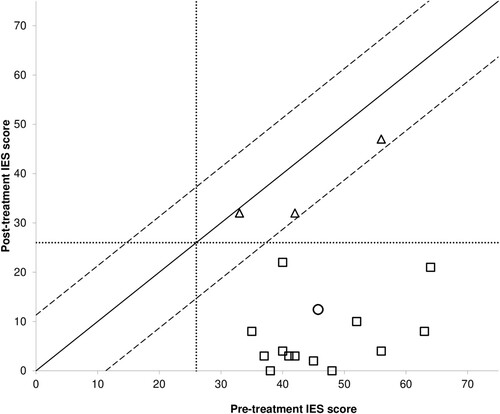Figures & data
Table 1. Sociodemographic and clinical characteristics of ABI patients with PTSD treated with EMDR who completed the IES.
Table 2. Treatment characteristics of ABI patients with PTSD treated with EMDR who completed the IES.
Figure 1. Individual IES scores of ABI patients with PTSD pre- and post-treatment with EMDR (n = 16).
Note: Plot showing the pre-treatment (X-axis) and post-treatment (Y-axis) individual patient’s Impact of Event Scale (IES) scores. The dashed lines mark the boundaries of reliable change (i.e. +/−11.31). The circle marks the mean group score pre- and post-treatment. Points above the upper boundary of reliable change represent statistically significant deterioration (i.e. reporting more symptoms after treatment as compared to before treatment), triangles within the dashed lines represent no statistically significant improvement over time and squares below the lower boundary of reliable change represent statistically significant improvement (i.e. reporting less symptoms after treatment as compared to before treatment). The dotted lines mark the IES clinical cut-off score of 26, IES scores right of and above these lines are considered clinically significant. Based on Morley and Dowzer (Citation2014).

Data availability statement
The participants of this study did not give written consent for their data to be shared publicly, so due to the sensitive nature of the research supporting data is not available.
